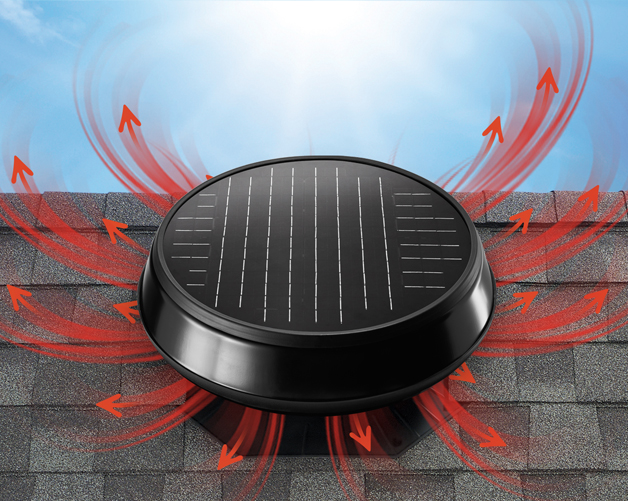
How Effective Are Solar-Powered Attic Fans?
If you add the right size attic fan and the right number of attic fans to your home they can make a tremendous difference in lowering the temperature in your attic and in your home. Want to keep your house comfortable year-round while protecting the attic and roof from a battery of hazards? An attic fan may be just what you’re looking for.
It’s midsummer, and for hours and days, the sun has been beating on the roof of your home. Measurements have shown that, given the right weather conditions, typical roofing materials can reach up to 150 degrees Fahrenheit. That heat eventually transfers from the outside of the roof to the sheathing. From there, it penetrates the insulation and roof framing materials, raising the temperature of the attic to a precarious extreme.
But summer isn’t the only season during which the attic faces a threat. In winter, when windows are shut tight, there’s considerably less ventilation for the humidity generated by cooking, laundry, and showers. With nowhere else to go, that moist air accumulates in the attic, where it can bring about a battery of risks.
Indeed, no matter the time of year, there are good reasons to give extra attention to your attic and the stresses that it undergoes.
How Important is Attic Ventilation?
A blisteringly high attic temperature isn’t uncomfortable only for the unfortunate soul standing in the unfinished space. If it goes high enough, the temperature in the attic can influence other rooms and make them hotter. Such inefficiency forces the air conditioning system to work harder than would otherwise be necessary, and of course, you must pay for that extra effort when the energy bills arrive every month.
Beyond the extra cost, trapped heat and moisture can end up doing real damage to your home by fostering mold growth. In extreme cases, excess moisture can even rot away portions of the key structural framing found in the attic.
Another possible consequence of runaway attic temperatures: The most common types of shingles—asphalt shingles—are plenty capable of withstanding heat when it comes from the sun. But when heat comes into contact with their undersides, those same shingles can fail prematurely.
Fortunately, there’s a straightforward solution to heat and moisture problems on and under the roof.
For money savings, a more comfortable home, and reliable protection for your roof (both its structure and shingles), consider installing an attic fan.
Designed to reduce both heat and moisture, a roof-mounted attic fan operates by a simple principle. The fan pulls warm air out through a roof vent, drawing in cooler outdoor air through existing vents located along with the soffits (on the underside of the roof overhang). That exchange of stale, warm air for fresh, cooler air relieves the added pressure put on the air conditioning. Now, the system can run more efficiently—and you can pay less on your monthly utility bill.
Does a Solar Attic Fan Save Money?
In the past, attic fans were always hardwired into the home and powered by electricity. Many homeowners saw that, while the attic fan may have been saving them some money, those savings were being erased by the cost of installing and operating the fan.
Luckily that’s no longer an issue with the Solatube Solar-Powered Attic Fan, which runs not on your home’s electrical system but on free and abundant natural sunlight.
Even as it keeps your attic cool and dry, the Solatube Solar-Powered Attic Fan requires no hands-on operation or maintenance. In fact, because of its whisper-quiet operation it’s likely that you’ll never even notice it’s running!
For one thing, Solar Star has been designed and manufactured to resist everything nature might throw its way, from wind and rain to snow and hail. Its power source—a series of small photovoltaic panels—is located right on the exterior cap of the fan. Made of durable composite, the cap reliably shields the more vulnerable components, ensuring powerful ventilation year-round. The brushless motor and lightweight, non-corrosive fan blades work in concert to keep the operating noise level down to a whisper.
Solar Star becomes even more effective with its add-ons. One such option is a thermal switch that automatically activates the fan once the attic temperature reaches a certain threshold.
A similarly handy extra: If you live on a shady lot and worry that your solar-powered attic fan won’t get enough sun to operate throughout the day, check out the add-on solar panel. An ingenious solution to the problem of tree cover—and for that matter, cloud cover—the supplemental panel can be placed on the sunniest part of your roof to ensure continuous operation.
It’s ironic: Problems caused by the sun—ranging from mere discomfort to devastating damage—can be solved with a Solatube Solar-Powered Attic Fan that relies on the sun!






